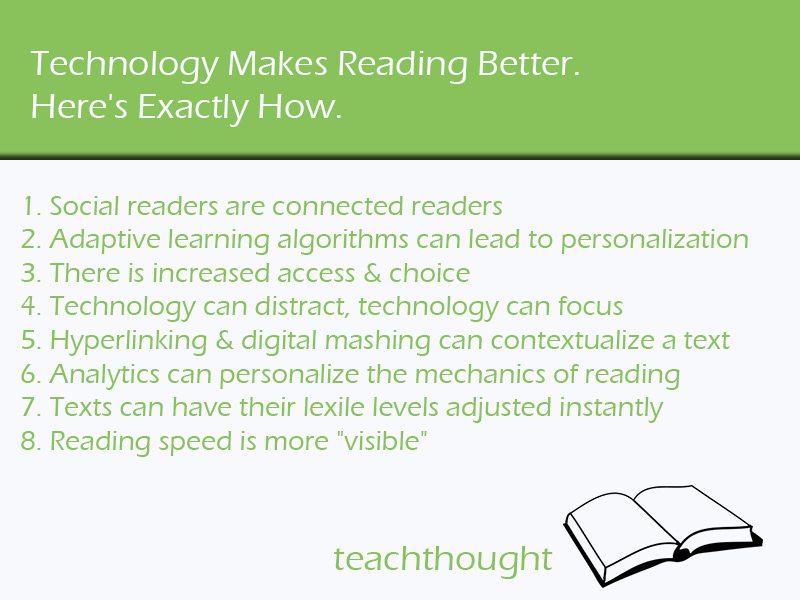
Exactly How Technology Can Make Reading Better
by Terry Heick
Let me be clear right away: I prefer physical books with soft (but a durable, right-kind-of-soft) covers.
In general, I dislike Readers as a matter of personal preference. This post, however, is not about what I ‘like.’ It’s also not about sentimentality. Rather, this is about how technology can make reading better for most people in most circumstances.
What Is Reading?
Recently I created a quick list of apps that support close-reading.
In that post, I theorized that “close-reading is the product of a dynamic and deeply personal interaction between the reader and a text. It is an active process characterized by questioning, adjusting reading rate, judgment thinking, and dozens of other reading strategies readers use to make sense of what they’re reading.”
Most teachers know what close-reading is. The part that I found most interesting was the seemingly alien idea of technology promoting patient reading. Apps, for example—how on earth can a tablet or an app or an iPad or headphones or some other gadget help with the focus, patience, curiosity, and will to sit with a text and make sense of it? The opposite seems more likely.
And that’s certainly possible. There is no ‘truth’ here. In one setting with one student in one kind of classroom, technology could overwhelm the fragile interaction between reader and text. In others, it could catalyze the reading process like never before.
But that’s a matter of design. Of strategy. Of context. At one point, books were considered ‘technology’ during a move from oral storytelling to written record. The same with certain kinds of binding, the printing press, and so on. Throughout history, reading–like nearly everything else–has been altered by technology.
Reading is just the communication of ideas through alphanumeric symbols. I’m not sure what this represents such hallowed ground for teachers, but it does. Personally I’d be more concerned with reading habits, reasons for reading, the quality of reading materials, etc. Symbols change, forms change, media change. See the gif and memes and language and acronyms that become words and words that become metaphors again. This is your audience, and these are the symbols they gravitate towards.
In the apps-for-close-reading post, I said that this ‘interaction’ between reader and text during close reading “doesn’t require technology, but can be changed by it.” So it made sense, I thought, to guess in some ways this happens. Or should be happening, anyway.
With more personalization, more access, and more connectivity, we should be creating a generation of close-readers that can’t get enough. So if we’re not, the question is, why isn’t that happening? The pieces are there.
Technology Makes Reading Better. Here’s Exactly How.
1. Social readers are connected readers
Through apps with social components, readers can be connected through texts. Reading groups, reading contests, reasons for reading, book suggestions, building social credibility for the process of reading, and more are possible when reading is, at least on some level, a social act.
No, we don’t always ‘need to be connected.’ This isn’t an either/or circumstance, however. We can be alone with our book and then socialize our reaction to the book. We can get an idea for a book and then be alone to read, then socialize again after. We can ‘socialize’ an idea and gain background knowledge for a certain chapter in a book, then read alone and not ‘socialize’ at all after. The point is, we can choose who we don’t and don’t socialize with, when, and how.
We have the choice.
2. Adaptive learning algorithms can lead to personalization
With adaptive learning algorithms, readers can have the pace, diversity, complexity, and form of their reading materials personalized instantly.
3. Increased access & choice
Through digital storefronts, free eBooks, RSS feeds, social magazines, and more, there has never been a time where students had more content at their fingertips. Like this book using an eReader like Kindle or iBooks? Here are 25 just like it.
Also, here are 10 other authors that those who liked this book also liked.
And here are 750 reviews that you can sift through to get a feel for what other people think. And please, download a free sample of any book you’d like.
And it’s easier than ever to publish, so while that means there’s more garbage out there, there’s also more variety. Fanfiction has exploded. If you can’t find something you like, you’re not trying.
4. Technology can distract, technology can focus
Technology can allow readers to annotate texts and share notes, which is physically interactive and ‘social.’ There are also apps–white noise apps, for example–that can block out class distractions, and more. Before you blame technology for ‘distracting’ students, make sure you’re honest with yourself about how focused they were without the tech.
5. Technology makes learning easier
Let’s breaking reading up into three separate categories: Before Reading, During Reading, and After Reading.
During each of these times, readers have different needs.
Before Reading: A young reader starting a story set in a different culture may benefit from watching a YouTube video about that culture, or reading a quick Wikipedia overview about it.
During Reading: A high school student reading a poem may want to Google the literary allusions in that poem to make better sense of what they’re reading.
After Reading: A PhD student may want to check previous studies by that study’s authors to evaluate some claim being made–or to follow up on some other data point found in the study to learn more.
The point is, technology (used well) improves ‘sensemaking.’ No, it’s not absolutely necessary in the same way that I don’t need to drive a car to drive to Henry County, Kentucky. I could walk if I wanted–and there are benefits to walking. Cars aren’t ‘superior.’ But because of that technology, I have the opportunity.
6. Analytics can personalize the mechanics of reading
Analytics can be, well, analyzed for the practice of reading—time spent reading, how often readers clicked on certain words, etc. I know this is vague. I’m not a reading specialist or an app developer. The point is that data can be used to keep all readers in their ‘literacy sweet spot,’ supporting struggling readers, challenging advanced readers, and offering choice to grade-level readers.
7. Texts can have their levels adjusted instantly
Take the data from #6, and you’ve got a powerful combination. This means less or more complex sentence structure, syntax, vocab, etc. Platforms like Epic reader and news-o-matic make it easier to match a reader to a text level, as do a variety of apps and desktop programs.
And using eReader apps, students can touch a word and get its definition instantly. Not that they necessarily will, mind you–close reading is still a matter of will. But they can.
8. Reading speed is more ‘visible’
With apps that allow the practice of sight words, others created expressly to increase reading speed, and others that measure time spent reading, words read per minute, and more, more than ever reading speed is visible, and higher reading speeds generally translates to increased comprehension.
9. Hyperlinking and digital mashing can diversify a text
Texts can be ‘layered’ with links and supplemental media to compensate for reading levels of background knowledge. This isn’t a distraction–done properly, this can contextualize the text.

